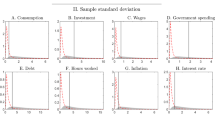Abstract
Many economic models are completed by finding a parameter vector θ that optimizes a function f(θ), a task that can only be accomplished by iterating from a starting vector θ0. Use of a generic iterative optimizer to carry out this task can waste enormous amounts of computation when applied to a class of problems defined here as finite mixture models. The finite mixture class is large and important in economics and eliminating wasted computations requires only limited changes to standard code. Further, the approach described here greatly increases gains from parallel execution and opens possibilities for re-writing objective functions to make further efficiency gains.
Similar content being viewed by others
References
Arcidiacono, P. and Jones, J.B. (2003). Finite mixture distributions, sequential likelihood and the EM algorithm. Econometrica, 71(3), 933–946.
Aguirregabiria, V. and Mira, P. (2002). Swapping the nested fixed point algorithm: A class of estimators for discrete Markov decision models. Econometrica, 70(4), 1519–1543.
Debreu, G. (1983). A social equilibrium existence theorem. In Mathematical Economics: Twenty Papers of Gerard Debreu, Econometric Society Monographs 4, Cambridge University Press.
Doornik, J.A., Hendry, D.F. and Shephard, N. (2002). Computationally-intensive econometrics using a distributed matrix-programming language. Philosophical Transactions of the Royal Society of London, Series A, 360, 1245–1266.
Eckstein, Z. and Wolpin, K.I. (1990). Estimating a market equilibrium search model from panel data on individuals. Econometrica, 58(4), 783–808.
Goldfeld, S.M., Quandt, R.E. and Trotter, H.F. (1966). Maximization by quadratic hill-climbing. Econometrica, 34(3), 541–551.
Heckman, J.J. and Singer, B. (1984). A method for minimizing the imapct of distributional assumptions in econometric models for duration data. Econometrica, 52
Hotz, J. and Miller, R.A. (1993). Conditional choice probabilities and the estimation of dynamic models. Reviews of Economic Studies, 60, 497–529.
Imai, S., Jain, N. and Ching, A. (2002). Bayesian estimation of dynamic discrete choice models. Manuscript, Ohio State, April, http://www.econ.ohiostate.edu/aching/research/bayes2c.pdf.
Judd, K.L. (1988). Numerical Methods In Economics. MIT Press, Cambridge.
Lee, D. (2005). An estimable dynamic general equilibrium model of work, schooling and occupational choice. International Economic Review, 46, 1–34.
Mcfadden, D. and Train, K. (2000). Mixed MNL models for discrete response. Journal of Applied Econometrics, 15, 447–470.
Nagurney, A. (1996). Parallel computation. In D. Kendrick, J. Rust and H.M. Amman (eds.), Handbook of Computational Economics, 331–400. North-Holland, Amsterdam.
Press, W.H., Flannery, B.P., Teukolsky, S.A. and Vetterling, W.T. (1987). Numerical Recipes: The Art of Scientific Computing. Cambridge University Press, New York.
Rios-Rull, V. (1999). Computation of equilibria in heterogenous agent models. In R. Marimon and A. Scott (eds.), Computaional Methods for the Study of Dynamic Economies: An Introduction. Oxford University Press, Oxford.
Rust, J. (1994). Structure estimation of markov decision processes. In R. Engle and D. McFadden (eds.), Handbook of Econometrics, Vol. 4, 30823139. North Holland, Amsterdam.
Rust, J. (1996). Numerical dyanmic programming in economics. In H. Amman, D. Kendric and J. Rust (eds.), Handbook of Computational Economics. Elsevier, North Holland.
Schittkowski, K. (2001). NLPQLP: A new Fortran implementation of a sequential quadratic programming algorithm for parallel computing. Manuscript, http://www.uni-bayreuth.de/departments/math/kschittkowski/nlpqlp_rep.htm.
Swann, C.A. (2001). Software for parallel computing: The LAM implementation of MPI. Journal of Applied Econometrics, 16(2), 185–194.
Swann, C.A. (2002). Maximum likelihood estimation using parallel computing: An intorduction to MPI. Computational Economics, 19(2), 145–178.
Author information
Authors and Affiliations
Corresponding author
Additional information
Documented code that implements the algorithm described is available from the author for objectives written in C and other languages. It runs in both serial and parallel mode using the MPI library.
JEL Classification: C61; C63; D58
Rights and permissions
About this article
Cite this article
Ferrall, C. Solving Finite Mixture Models: Efficient Computation in Economics Under Serial and Parallel Execution. Comput Econ 25, 343–379 (2005). https://doi.org/10.1007/s10614-005-6413-3
Accepted:
Issue Date:
DOI: https://doi.org/10.1007/s10614-005-6413-3




